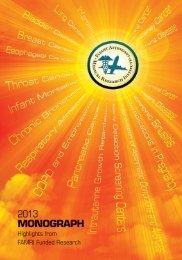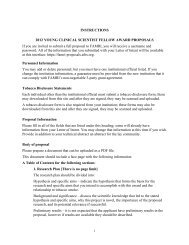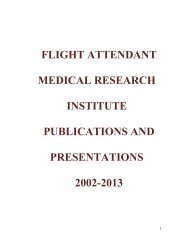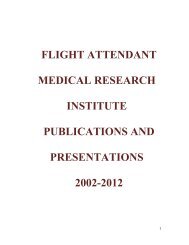MISSION
2009 compendium of FAMRI-supported research - Flight Attendant ...
2009 compendium of FAMRI-supported research - Flight Attendant ...
You also want an ePaper? Increase the reach of your titles
YUMPU automatically turns print PDFs into web optimized ePapers that Google loves.
ability to detect early emphysematous changes in the lung. This is especially important for exposure to<br />
SHS because oftentimes the level of exposure is subtler than what active smokers receive and, therefore,<br />
much more sensitive detection methods are needed. A highly sensitive, noninvasive image-based detection<br />
method will not only transform one’s ability to detect and follow treatment of the disease process, but may<br />
be the only way to detect early emphysematous disease.<br />
FAMRI Supported Publications<br />
Patz S, Muradian M, Hrovat MI, Hersman, FW, Hatabu H, Butler JP. Xenon MRI of the lung. In:<br />
Kauczor HU, ed. MRI of the Lung. Springer Verlag, 2009.<br />
THE ROLE OF BRONCHIO-ALVEOLAR STEM CELLS IN CIGARETTE SMOKE-RELATED EMPHYSEMA<br />
Shivraj Tyagi, PhD; Brigham and Women’s Hospital; CIA 2008<br />
COPD is a complex human disease mainly influenced by active tobacco exposure and SHS. A greater<br />
understanding of pathways contributing to lung maintenance and repair is needed to identify mechanisms<br />
contributing to COPD. It is believed that following smoke-induced injury to the lung, reparative mechanisms<br />
are active and may contribute to individual variability in exposure-related disease susceptibility.<br />
Peroxisome proliferator-activating receptor (PPAR)-gamma is a well-known regulator of cellular differentiation<br />
and tissue homeostasis/inflammation. Their laboratory has shown that deficiency in PPARgamma<br />
specifically within airway epithelial cells leads to increased susceptibility to the development of emphysema<br />
in response to chronic cigarette smoke exposure. Recent studies have discovered a population of airwayderived<br />
progenitor cells capable of repairing the airway and airspace, bronchioalveolar stem cells (BASCs),<br />
which are identified by co-expression of Clara cell secretory protein (CCSP) and surfactant protein C<br />
(SPC). In vitro, these cells show characteristics including self-renewal and multi-potency, such as the ability<br />
to generate both Clara cells and type II pneumocytes. It is reasoned that BASCs may play a role in repairing<br />
cigarette smoke-related lung damage in the setting of emphysema. Since airway epithelial cell-targeted<br />
PPARgamma deficiency leads to increased susceptibility to smoke-related emphysema-like pathology, it is<br />
suggested that PPARgamma function in BASCs can modify this response by contributing to the regulation<br />
of BASC differentiation and progenitor cell potential. They have verified PPARgamma expression within<br />
BASC, and have confirmed targeting of this cell population in airway epithelial cell PPARgamma deficient<br />
mice. They provide preliminary data describing changes in gene expression in BASCs in wild-type mice following<br />
smoke exposure and in BASCs deficient in airway epithelial cell PPARgamma. They propose that<br />
BASCs are necessary for lung repair in response to cigarette smoke exposure and that PPARgamma is capable<br />
of modulating the progenitor potential of BASCs by controlling cell differentiation.<br />
They will test these hypotheses by 1) investigating the effect of cigarette smoke exposure upon BASC<br />
function in vivo and in vitro, and 2) defining the contribution of BASC proliferation and function to<br />
increased susceptibility to smoke-related lung disease in PPARgamma-deficient mice. These studies will<br />
extend understanding of the biological functions of BASCs, assess novel mechanisms contributing to cigarette<br />
smoke-related lung injury and repair, and identify novel targets for therapeutic intervention in<br />
patients with COPD.<br />
HAEMOPHILUS INFLUENZAE TOLERANCE: A MECHANISM FOR CHRONIC COLONIZATION IN COPD<br />
Tricia D. LeVan, PhD; University of Nebraska; CIA 2008<br />
COPD is the fourth leading cause of mortality worldwide and is characterized by chronic airway inflammation<br />
and nonreversible airflow limitation. While tobacco smoking is the leading risk factor for COPD,<br />
even secondary causes of COPD, such as SHS exposure, are a major public health concern. Each year the<br />
proportion of patients with COPD who are life-long never smokers rises.<br />
In addition to tobacco smoke being the main etiological factor of COPD pathogenesis, recent studies<br />
have found that tobacco exposure is a major risk factor for respiratory tract infections. Studies also show<br />
that cigarette smoke reduces bacterial clearance by impairment of mucociliary clearance, changes in<br />
pathogen adherence, and disruption of the bronchial epithelium. The bronchial epithelium is in a key position<br />
to regulate inflammation, but it remains unknown whether the epithelium becomes hypersensitive or<br />
tolerant to the chronic presence of bacteria. Nontypeable Haemophilus influenzae (NTHi), the most common<br />
pathogenic bacteria isolated from the airways of patients with COPD, are recognized by bronchial<br />
epithelial cells by directly interacting with toll-like receptor 2 (TLR2).The overall hypothesis of this study<br />
is that chronic exposure of bronchial epithelial cells to cigarette smoke and/or NTHi induces innate<br />
immune dysfunction characterized by bronchial epithelial tolerance that perpetuates chronic colonization<br />
in individuals with COPD.<br />
P A G E 1 5 3







